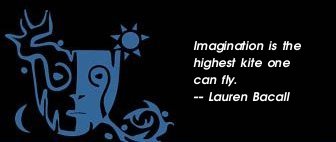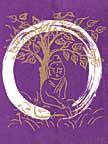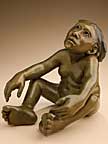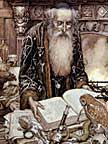|

Talking with Michael Green
By Mary Davis, Editor
What words do I use here? I struggle to find the words to describe artwork that
is so visceral, so radiant, so lyrical that it touches my heart, and makes me
want to move away from the computer to sing and dance and weep in joyous
devotion to that which is most sacred! Those of us who attend Mythic Journeys
2006 will have this inspiration for several days because
Michael Green
is the artist who is shaping the “Experience Design” for this Mythic Journeys
Conference and Performance Festival.
 It
is even more difficult to find the words to describe the artist himself. I met
Michael Green first when our Mythic Journeys leadership group spent an
afternoon in discussion with him, starting with his reading from The I Ching,
The Book of Changes , which he had consulted before he left
Pennsylvania for Atlanta. His reading was Number 48: Ching/ The Well
, which in Wilhelm’s translation begins, “Wood is below, water above. The wood
goes down into the earth to bring up water…the well from which water is drawn
conveys the further idea of an inexhaustible dispensing of nourishment…” Before
the afternoon is over, we see and touch the beautiful cedar box Michael carved
to hold treasures like the sensuous wooden holders for the raptor wing feathers
of ceremonial fans and the vellum with exquisite drawings and script. He was
trying to sort out what his presence at “the gathering,” Mythic Journeys, would
be, and we were getting to know him. Then the following day, Michael and I met
at my favorite coffee shop for an in- depth interview and conversation, which I
hope to convey to you here. It
is even more difficult to find the words to describe the artist himself. I met
Michael Green first when our Mythic Journeys leadership group spent an
afternoon in discussion with him, starting with his reading from The I Ching,
The Book of Changes , which he had consulted before he left
Pennsylvania for Atlanta. His reading was Number 48: Ching/ The Well
, which in Wilhelm’s translation begins, “Wood is below, water above. The wood
goes down into the earth to bring up water…the well from which water is drawn
conveys the further idea of an inexhaustible dispensing of nourishment…” Before
the afternoon is over, we see and touch the beautiful cedar box Michael carved
to hold treasures like the sensuous wooden holders for the raptor wing feathers
of ceremonial fans and the vellum with exquisite drawings and script. He was
trying to sort out what his presence at “the gathering,” Mythic Journeys, would
be, and we were getting to know him. Then the following day, Michael and I met
at my favorite coffee shop for an in- depth interview and conversation, which I
hope to convey to you here.
While Michael is a critically acclaimed artist, he is also a craftsman, a
sculptor, a builder of earthshrines and installations, writer, television art
director, and musician (The Illumination Band). He creates his work as an
intuitive response to the spiritual, and he views art as a process of getting
aligned with the Great Mystery.
Born in New York City in 1943, he says his inability to master a foreign
language in high school was a factor in his attending New York University,
which had no art department, and may therefore have been a good thing. He says
that art has no canon now in contrast to dynastic China, Florence in the 1500’s
and Paris in the 1920’s, except possibly the ability to generate “buzz.” But
more about art later.
 Michael Green’s life included film school and study at the University of Sao
Paulo in Brazil. In his twenties, he hitchhiked around both the Amazon Basin
and the United States. He continued his studies which included the gospel of
Ramakrishna and in the 1960’s he became a monk. He thought of himself as a
saddhu, a celibate renunciate. People invited him here and there, and he
eventually lived for a time in a tipi on a mountain outside Woodstock, N.Y. A
Conscientious Objector during the Vietnam War, he also worked on light shows
with Timothy Leary.
Michael Green’s life included film school and study at the University of Sao
Paulo in Brazil. In his twenties, he hitchhiked around both the Amazon Basin
and the United States. He continued his studies which included the gospel of
Ramakrishna and in the 1960’s he became a monk. He thought of himself as a
saddhu, a celibate renunciate. People invited him here and there, and he
eventually lived for a time in a tipi on a mountain outside Woodstock, N.Y. A
Conscientious Objector during the Vietnam War, he also worked on light shows
with Timothy Leary.
His Teacher, Bawa
Michael eventually found his way to Pennsylvania to study with the Sufi master
Bawa Muhaiyaddeen. Among the aspects of his life affected by his studies with
Bawa, who told him that he was almost a jnani and that he looked like
a bridegroom
, was the instruction by Bawa to become a householder. Michael says now, “There
are certain lessons only a wife can teach.” His wife is also an artist and his
son is a member of The Illumination Band. They live in the countryside in the
Philadelphia area near Bawa’s burial site, The Mazar, where Michael has created
what might be called an earthwork or a sacred environment.
In his dedication of A New Illuminated Rumi, One Song
to Bawa, Michael includes a visual image of Bawa, and he writes, “For Bawa, who
was truth made visible, who shared his love secrets. Who taught us Separate
from yourself that which separates you from others.” Visual images of Bawa may
also be seen on pages 83 and 85 of The Illuminated Rumi which Coleman
Barks and Michael Green created in collaboration. Coleman and Michael met as
they both studied with Bawa, and they have also collaborated on another of
Michael’s (and Coleman’s) books, The Illuminated Prayer: The Five-Times Prayer
of the Sufis
.
One of my questions to Michael was how his contact with Bawa was made. He says,
“As soon as you saw him, you knew
.” In Woodstock, Michael had met Jonathan Granoff, who was an aide to Senator
Alan Cranston and now heads the Global Security Institute. He says, “Jonathan
and I knew we had dirt on the back of our necks which we couldn’t see. We
needed the perfect mirror, and we agreed to let one another know when we found
one, one of what some might call ‘the nobody home-ers.’” They found Bawa in a
Philadelphia row house after hearing a student from Ceylon describe him.
 According to the
stories, Bawa had been found sitting in a tree outside a village in Sri Lanka
in the early 1940’s. He spoke both Sanskrit and Arabic, as well as other
languages including Tamil and English. His name, Muhaiyaddeen , means restorer
of the true light, of the “deen,” of the path. No one knew
how he arrived at that tree, but people sensed that he had been around a very
long time. He had a sense of humor, and Michael tells the story about Bawa’s
making a low level joke about Ganesha’s blowing his nose, and then looking up
and asking, “Green Michael, do you have any problem with this?” Michael
responded that at the very least, since Ganesha is held in reverence by
millions of people, it is strange to treat him like this. Bawa looked at
Michael and said, “He who first sang the Vedas can make fun of Ganesha.”
Michael says you could feel
the truth of this, that Bawa had been here a very, very, very long time, long
enough to have been a first singer of the Vedas. Bawa, he says, was like Shiva,
“He would go after whatever it was you were crystallizing your identity around,
and be a flamethrower.” According to the
stories, Bawa had been found sitting in a tree outside a village in Sri Lanka
in the early 1940’s. He spoke both Sanskrit and Arabic, as well as other
languages including Tamil and English. His name, Muhaiyaddeen , means restorer
of the true light, of the “deen,” of the path. No one knew
how he arrived at that tree, but people sensed that he had been around a very
long time. He had a sense of humor, and Michael tells the story about Bawa’s
making a low level joke about Ganesha’s blowing his nose, and then looking up
and asking, “Green Michael, do you have any problem with this?” Michael
responded that at the very least, since Ganesha is held in reverence by
millions of people, it is strange to treat him like this. Bawa looked at
Michael and said, “He who first sang the Vedas can make fun of Ganesha.”
Michael says you could feel
the truth of this, that Bawa had been here a very, very, very long time, long
enough to have been a first singer of the Vedas. Bawa, he says, was like Shiva,
“He would go after whatever it was you were crystallizing your identity around,
and be a flamethrower.”
Michael says that in our world, in our culture, we don’t usually think of
sitting at someone’s feet to learn, but he felt truly
human when he was at the feet of Bawa. Much of the teaching was directly with
the individual. One of the reasons Michael stayed with Bawa as a student was
that he could have living, intimate, immediate interaction with him. Bawa would
burst into spontaneous song, was aware of invisible beings, and “accomplished a
huge amount of work in invisible realms.”
Bawa considered Michael “Artsmaster,” although Michael says this was no big
deal. Bawa also considered art as “a shiva/shakti thing, one of the sixty-four
sexual arts, keeping a circuit open.” Bawa made clear in his teachings that
we’re entering “the destruction,” that 43 signs had been given to him, 41 of
which had already happened by 1985, when Bawa left, after being routinely ill
off and on for three or four years. Michael says that a “nasib” is a contract
with every soul for a certain number of years (to live on this plane). Bawa had
experienced a number of extensions of his contract and “you could feel that he
was stretched thin.” He feels that in reality, Bawa is now inside him, and he
said, “He is my wisdom, my soul, which in a miraculous way has taken form.”
Rumi, Art, and the Creative Process
We continued to discuss in an interwoven way, Michael’s art and his creative
process, as well as his teacher, life itself, society, the sacred, our work at
Mythic Journeys, and more, including healing or stopping the potential
“destruction.”
 He says that if he, Michael Green, has a public face, it’s because of his work
with Rumi. He sees Rumi as a voice for change. He loves the combination of word
and image, saying that the art of illumination is like “a well executed comic
book, with lots of illustration, hopefully balancing the right brain
(predominantly images) and the left brain (predominantly words) and addressing
the whole creature.” He finds a kind of ceremonial magic in the image: the
image conveys a different kind of thing than the concept, ie: the color red
conveys red better than r-e-d. “At the far end of the spectrum, images can
convey a non-verbal kind of understanding about mystical events, and best of
all, are the two (images and words) together.”
He says that if he, Michael Green, has a public face, it’s because of his work
with Rumi. He sees Rumi as a voice for change. He loves the combination of word
and image, saying that the art of illumination is like “a well executed comic
book, with lots of illustration, hopefully balancing the right brain
(predominantly images) and the left brain (predominantly words) and addressing
the whole creature.” He finds a kind of ceremonial magic in the image: the
image conveys a different kind of thing than the concept, ie: the color red
conveys red better than r-e-d. “At the far end of the spectrum, images can
convey a non-verbal kind of understanding about mystical events, and best of
all, are the two (images and words) together.”
Michael adds that visual images also make you read the books more slowly, and
that if you go through Rumi’s poems quickly, you are not getting them. “Rumi
really wants to stop you in your tracks!” Once Michael gets the initial
metaphor, he works from that, and he says it does not have to be Persian-esque,
because he wants to bring Rumi forward as a world figure.
He brings art, science, and religion together in his work, combining images
like the photo of a tungsten atom with fractals and the image of a mosque,
working digitally. He has spent much time studying sacred art, and he says the
more elegant the system, the more the form of art is looked upon as a road map,
like a Tibetan thanka. The use of an original gives him a clear sense, a way to
fit elements together, and he says that if he is sensitive to it, he finds a
way to bring together what belongs together. He also says, “a dangerous thing,
appropriating,” implying to me that he takes great care in the elements he
combines.
We discuss imagining the Paleolithic tribesman or woman picking up a burnt
stick, drawing an image of a human figure on the wall of a cave, and the shock,
the magical power, when the person really sees the image. Michael says that art
seems to have often been reserved for what is most important, for the shamanic,
to make the veils thinner (between the worlds or dimensions); that for probably
90% of our human time on earth, art has been special, magical, mysterious, with
canons. As he says, a Hopi blanket tells a story. He notes that an
anthropologist working in Bali at the turn of the century was told by the
translator that the language had no word for “artist” because life is art
.
“Traditional culture is not just a stage set, it is a profoundly different mind
set,” and then he draws for me our culture’s linear view of time with Alpha at
the beginning of a straight line and Omega at the end, and after that, he draws
traditional time as a circle that is continuous, that is more like a dance,
more dreamlike. While I know this intellectually, as Michael draws, it sinks
in, and I catch a glimpse of what it would be like to really experience time in
a profoundly different way, a traditional circle of time, and I am moved.
Michael sees the profane and the sacred as figure and ground. He is working now
on a chant that says, “Reality is a rendering of neurology.” We discuss the
“whatever it is” nature of the realities we perceive and that it appears that
traditional people are anchored in a different parallel dimension.
When I ask him more about his own creative process, he says that for him two
aspects are important. First is the “forbidden aspect,” through some sort of
spiritual practice, you clear your mind, so that the first thing that rushes in
to fill the space is a muse (“Woof!”), the experience, the bright idea, the
insight. The other aspect for him is that working digitally, there is a fluid
play and you feel warmer or colder and you know when it’s right, and then he
quotes Duke Ellington, “It don’t mean a thing if it ain’t got that swing.”
Society, the “Destruction,” the “Afterculture,” and Myth
Throughout our conversation, we have discussed the difficulties we all face in
today’s world, difficulties on a personal level (like money, capacity,
responsibility) and on a societal level. Michael speaks of the part of mythic
imagination that is learning to be impeccable in the real world (or in the
unreal world), that an impeccable warrior handles whatever situation he (or
she) is in, appropriately, whatever the rules are. He cites as an example, the
story from Castaneda when Don Juan says, “Meet me in the park in Mexico City.”
Carlos did not really expect him to be there, but when Carlos arrives, there is
Don Juan and he’s on time and
wearing a three piece suit!
 On the issues we face in our collective society, Michael’s questions include,
“What went wrong? Where and when? Is there a fatal flaw that can’t be fixed? Is
there an ‘Andromeda Strain’ virus in our culture, let loose long ago, reaching
some sort of Wagnerian kettle-drum climax now? If only we could put the genie
back (the atomic bomb). Where is this going? Is our culture on a runaway train?
Here we are again, just like with the Vietnam War. What is the role of
‘progress?’ Are we in a chaotic, violent breakdown of civilization, like a
black hole in space?” He continued that at one of the recent meetings he
attended, both Democrats and Republicans agreed that “our kingdom is in peril.”
As he says, it is not that people are “bad,” but that the dialogue has gotten
so distorted and that we need to get back into “proper balance.” And he said
that Bawa taught that we are entering ‘the destruction.”
On the issues we face in our collective society, Michael’s questions include,
“What went wrong? Where and when? Is there a fatal flaw that can’t be fixed? Is
there an ‘Andromeda Strain’ virus in our culture, let loose long ago, reaching
some sort of Wagnerian kettle-drum climax now? If only we could put the genie
back (the atomic bomb). Where is this going? Is our culture on a runaway train?
Here we are again, just like with the Vietnam War. What is the role of
‘progress?’ Are we in a chaotic, violent breakdown of civilization, like a
black hole in space?” He continued that at one of the recent meetings he
attended, both Democrats and Republicans agreed that “our kingdom is in peril.”
As he says, it is not that people are “bad,” but that the dialogue has gotten
so distorted and that we need to get back into “proper balance.” And he said
that Bawa taught that we are entering ‘the destruction.”
I ask Michael what he thinks we can do to turn things around and if Bawa had
suggestions to stop or transform “the destruction?” He has thought about this a
great deal. He discusses a complete surrender into absolute unknowing and the
rebirth of an ancient sanity, perhaps in a great spontaneous gathering like the
Khumba Mela. He has written a book about this which is not yet published and
which he may choose not to publish, not to make concrete. “Anytime you put
something out there, it takes form,” he says, “so it is important to keep it
fuzzy, to keep the gauze scrim.”
When you visit Michael’s website www.MichaelGreenArts.com
you will see his image of what he terms the River of Sanity. There he says,
”This River of Sanity is nourishing a new and vital culture committed not only
to personal transformation but to a planetary ethic that cherishes Earth as a
living entity and understands all consciousness as a continuous field.”
He continues, “To explore the dimension of MYTH, mythologies are stories that
nourish the soul. Generally set in the past, authentic mythologies must also
live in the present.” Painting a vivid word picture as he sketches a visual
image, he says, “Dancing on the event horizon, trying to imagine a future
mythology, surrendering to the unknown! The event horizon is at the black hole
where the sat-guru sits as the bridge, one foot inside space/time, and one foot
beyond space/time and at the other end, the white hole, is the goddess
emerging.”
On Bawa’s teachings on stopping or transforming the “destruction,” Michael says
that curiously Bawa downplayed this, going on to explain that insan kamil
is Arabic for a true, primeval, enlightened human being, and that sixteen
people who are true humans profoundly seeing through the dream-like nature of
reality and with the compassion to make adjustments to the dream… perhaps???
“In a dream, do you stop the tyrannosaurus or do you become the Dreamer?”
We spoke about the importance of soul and heart, the importance of imagining
a shift in consciousness and how it would manifest on the everyday, mundane
level of life. Becoming natural people again, effecting major change and
becoming a “traditional culture,” recovering heart quality and mythical
thinking (a sacred world view) are aspects of the “North American Afterculture”
which Michael envisions and refers to as “future anthropology.” “I think the
most important myth of our time right now is the one all of us (the people who
come to myth and who come to this Mythic Journeys gathering) are engaged in. It
is the ‘hero with a thousand faces’ going forth to save the City, going forth
to save the Country.”
He quotes his wife’s insights into mythology. She says that mythology
traditionally was a grand tale that people told themselves in order to anchor
their identity and their purpose in a great, seizing, turbulent universe. Then,
as the age of science came in, and indeed, the mythology of science became the
new mythology, the word “myth” became synonymous with falsehood. Then in modern
times, Jung and Hillman and others have restored myth to an honored place, but
they brought it back in a much more inward, individual path, the psychological
dimension.
Michael says that, with his vision of the “Afterculture,” he is hearkening back
to the primeval use of myth as a great narrative for people and individuals who
are undertaking to save the kingdom, “And so, I’m bringing in a slightly
different focus, it’s contextualizing…”
On his website, he explains more of his vision of the Afterculture, “America is
now giving birth to a mythology of the future. It’s half formed, but already
deeply embedded in our collective consciousness – it’s the Road Warrior vision
of an After- the- Collapse, where things get wild. It’s clearly an intuition of
the huge changes that are bearing down on us, but it may be ill-informed. A
breakdown of the old order does not necessarily mean a collapse into violence
and anarchy. That River of Sanity culture has deep roots, it waits, it bides
its time, and it brings with it a new, organic kind of community. What might we
become, freed from the crushing weight of the old order? If we could embrace in
our hearts and live out in our lives a sacred and sustainable path? Sometimes
the quest for understanding something begins by naming it: so let us call it
the Afterculture.”
 Quoting Michael again, “We are witness today to the emergence of an ancient
spiritual vitality into modern affairs. Call it the River of Sanity
, an underground current which has run through all history, nourishing
visionaries in every tradition. It comes from the deepest wellsprings of our
humanity, and it moves us into harmony with the natural world and ourselves. It
does not contradict scientific thought, but the river offers a profoundly wider
way of engaging reality. It is caught, rather than taught. My work is to
illuminate this emergence in the style or media most appropriate to the
moment.”
Quoting Michael again, “We are witness today to the emergence of an ancient
spiritual vitality into modern affairs. Call it the River of Sanity
, an underground current which has run through all history, nourishing
visionaries in every tradition. It comes from the deepest wellsprings of our
humanity, and it moves us into harmony with the natural world and ourselves. It
does not contradict scientific thought, but the river offers a profoundly wider
way of engaging reality. It is caught, rather than taught. My work is to
illuminate this emergence in the style or media most appropriate to the
moment.”
He sees this gathering, Mythic Journeys, as a perfect expression of a new kind
of culture, “a gathering of the lost tribe, trying to identify each other and a
plan of action, and the most difficult thing is that it’s not simply an outer
task, but for the task to succeed, we each have to become a different kind of
person.”
Amen, Brother Michael!!!
Return to Passages
Menu
Subscribe to the Passages
e-zine
|









